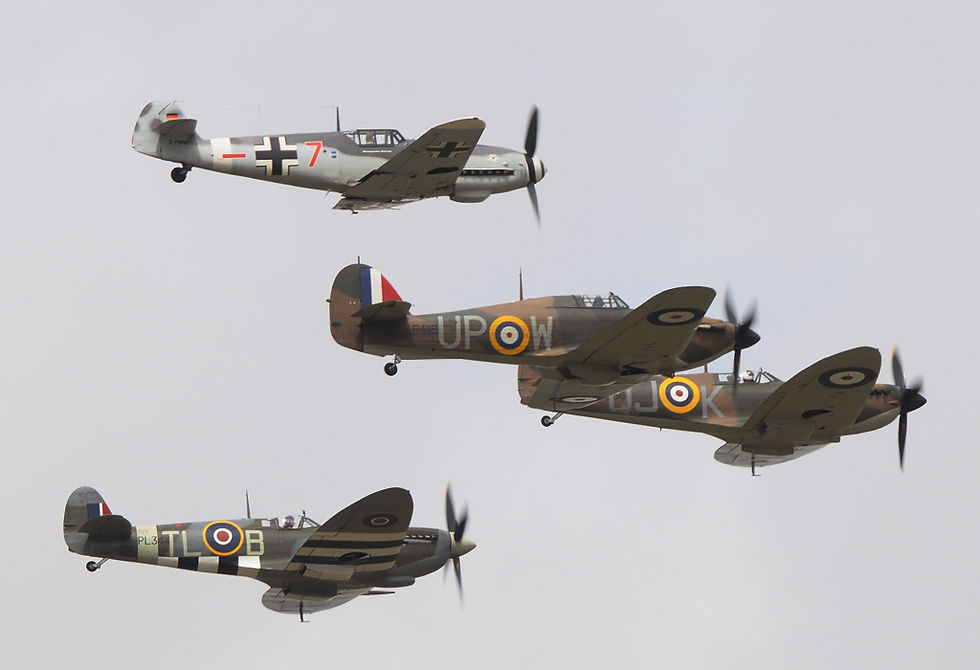Other Side of the World: Fighter vs Interceptor Roles in WWII Europe
- baronsfel001
- Jul 17, 2021
- 5 min read

Pictured above is another airshow image borrowed from the internet; always give credit where it is due. This post continues the trend after Hellcat Ace in which a game overview is followed by a commentary on the real-life basis the game simulates. This is not only to set context thus help contribute to the immersion factor but, in the case of these military simulations, serve as the author's own tribute to the actual warriors who gave their lives for the cause of patriotism, a noble trait that in the 21st century has been less-appreciated. While it is true the merit of causes fought for is its own topic of debate, bravery of those who fought must be still be appreciated as well as the wisdom these men exercised in making the most out of what they had to work with.
To elaborate, the post following Hellcat Ace focused on how American pilots in the Pacific redressed the inferiority of their fighters to the Japanese by adapting team tactics that minimized enemy strengths, turning the tide even before new fighters were introduced that equalized the technological front. In the European theater, however, Axis and Allied frontline fighters performed so similar to each other it was never a matter of technological superiority or a battle of power versus agility as it was in the Pacific. Rather, though the Second World War in Europe would be decided by attrition just as the First had, while the fight was more equal it was more about assigned roles with requisite initiative.
In the air during WWI standard fighters doubled as interceptors and it would take until after the war for roles to mature, or even for the terms "fighter" and "interceptor" to develop. What did come to full fruition that would be carried on in the next war was strategic bombing; though it was never executed to more than a tiny fraction of the extent it would be in the 1940s it defined the interceptor role that still exists today. It turned out the attributes of a good interceptor matched those of another role finding its place: the strike fighter. Primary assets were durability and firepower, with speed secondary and agility an optional bonus.
Fighter-to-fighter combat in the early days were turning dogfights, and with machines of similar relative performance that often remains the case unless the engagement gets decided in the initial pass. With firepower a stronger deciding factor than marksmanship, such a victory on the initial pass was infrequent until the introduction of guided air-to-air missiles of which none were in service before the end of WWII. But as alluded to in the previous ACM analysis, agility is a winning asset only if the engagement actually becomes a turning dogfight, a scenario that can be avoided should one party choose instead to utilize power to seize back the initiative. Today, as in WWII, the best fighters have a good balance of both speed and agility, though it is up to the pilot to use both best because emphasizing one means trading in the other. Fighters typically being less-durable than ground strike assets, strength and firepower are secondary attributes though having either certainly helps more.
On the western European front, firepower was a mixed bag but the trend became for the Allies to focus on fast-firing machine guns while the Luftwaffe boasted slower-firing but more powerful cannons. As it turns out (and would take about a decade after the war for America to finally figure out) it was Germany who had the correct idea: particularly against protected targets such as bombers or ground forces a few powerful hits trumped many weaker ones assuming regular marksmanship. Granted it got overdone at times (such as 57mm, which proved useless hitting aircraft though great against ground targets), but when the supersonic era arrived and made aerial machine guns obsolete for good the best balance was found to be between 20mm and 30mm depending on how the shells were designed.
What makes the Battle of Britain such an interesting scenario that gets revisited in simulations so often is that it featured the starkest of these firepower focus differences. In the late war RAF fighters matched their Luftwaffe counterparts with a mix of various machine guns and cannons, but in 1940 both the Spitfire and Hurricane carried eight machine guns chambering the standard .303 British battle rifle caliber. The Germans, like the Americans, developed an early appreciation for heavy machine gun calibers as an almost perfect balance between firing rate and bullet impact as well as adding a single cannon to some fighter models (P-39, Bf 109) to add extra punch for greater versatility. There was also trialing of the idea of a strong-but-slow type of fighter that relied on firepower coverage over dogfighting ability like the WWI Bristol F.2, but the Bf 110 would only prove how inviable such an idea was in actual fighter combat and become far more useful in the interception, escort and strike roles.
Being on the defensive it was Britain in 1940 who would set the stage for the rest of history in regard to these air-to-air combat roles. Both primary RAF fighters were identical in firepower making that factor impertinent. The darling Spitfire was more powerful, ruled at higher altitude, and could virtually-match the performance of its main counterpart the Bf 109 while the older, slower Hurricane could outmaneuver both. On paper it would seem simple enough to have the Spitfires intercept bombers with Hurricanes occupying the escort, yet while the Hurricane was indeed capable of holding its own in a dogfight its resilience actually made it the superior interceptor (and would account for the majority share of RAF kills in the battle).
When the tide turned in 1942 it would be Germany facing a similar challenge. The supreme Focke Wulf 190 was strong enough to be an ideal interceptor (so durable, in fact, that a more-armored variant was produced for the strike fighter role) but if loaded light could still maneuver well enough to outlast most opposition in a dogfight. Newer models of the venerable Bf 109 were fast enough and remained capable dogfighters, but were never built very durable or with great firepower thus suffered when pressed into the interceptor role (which happened often due to the scale of Allied strategic bombing attacks). Had the Me 262 jet, unbeatable as an interceptor and uncatchable by any piston-engine fighter, not been so delayed it could have changed the dynamic a great deal more than it did, but by 1944 attrition of competent pilots had already made final defeat of the Luftwaffe just a matter or time.
This new dynamic of transitioning from subsonic propeller combat to supersonic jet combat never got a true test in WWII; that would have to wait for Korea...





Comments